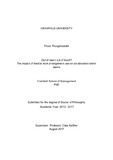JavaScript is disabled for your browser. Some features of this site may not work without it.
| dc.contributor.advisor | Kelliher, Clare | |
| dc.contributor.author | Thorgeirsdottir, Thora | |
| dc.date.accessioned | 2019-07-04T11:58:01Z | |
| dc.date.available | 2019-07-04T11:58:01Z | |
| dc.date.issued | 2017-08 | |
| dc.identifier.uri | http://dspace.lib.cranfield.ac.uk/handle/1826/14293 | |
| dc.description.abstract | Organisations are faced with a growing interest in flexible work arrangements that enable employees to control where, when and for how long they work and need to find ways to adapt and integrate these practices into work routines and processes. Because these arrangements reduce employees’ facetime at the office, doubts remain regarding their impact on collaboration within teams. In this thesis I explore the impact of the use of part-time work, telework and flexible working hours on collaboration within teams and the contextual features that explain this relationship. Seven case studies were conducted in software development teams in three organisations in The Netherlands and Belgium. Findings suggest that telework, part-time work and flexible working hours impact on collaboration within teams because of reduced passive facetime – passive presence of team members at the office without necessarily engaging in interactions with each other. Passive facetime was interpreted as availability to others and an enabler to collaboration. A theoretical framework is put forth outlining six sets of contextual features that impact on this relationship. At the team-level, these included skill differentiation, task characteristics (task complexity and goal clarity), temporal characteristics (temporal stability and task urgency) and structural characteristics (regular face-to-face meetings, amount of absence, predictability of absence and synchronisation of presence). At the individual level, proactive behaviours were found to have an impact. Finally, the whole framework is nested in and dependent on environmental characteristics, in particular the organisational setting. This thesis contributes to theory by outlining the double-faceted role of passive facetime in the relationship between FWA use and collaboration, by delineating how structural characteristics can provide teams with sufficient passive facetime, and by presenting a framework explaining the influence of FWA use on collaboration and the features that explain how and when this happens. | en_UK |
| dc.language.iso | en | en_UK |
| dc.rights | © Cranfield University, 2015. All rights reserved. No part of this publication may be reproduced without the written permission of the copyright holder. | |
| dc.subject | Telework | en_UK |
| dc.subject | part-time work | en_UK |
| dc.subject | flexitime | en_UK |
| dc.subject | facetime | en_UK |
| dc.subject | context | en_UK |
| dc.subject | collaboration team | en_UK |
| dc.title | Out of reach out of touch? The impact of flexible work arrangement use on collaboration within teams | en_UK |
| dc.type | Thesis | en_UK |
